VHC Vitamin-D
Quantitative Vitamin D Test [REF] 1000J-10/-25/-50
NOTE: THE ORIGINAL/REFERENCE VERSION OF THIS DOCUMENT IS THE ENGLISH VERSION.
Training Document for Professional Users
For Self-Study and Reference
![]() The VHC Vitamin-D test is an innovative Point of Care Vitamin D test for professional use, providing lab-grade results within 15 minutes. There has been a thorough, robust, and reliable process development of the test within the cassette. The VHC Vitamin-D enables the consultant and therapist to measure the important health parameter Vitamin D directly and anywhere at the Point of Care.
The VHC Vitamin-D test is an innovative Point of Care Vitamin D test for professional use, providing lab-grade results within 15 minutes. There has been a thorough, robust, and reliable process development of the test within the cassette. The VHC Vitamin-D enables the consultant and therapist to measure the important health parameter Vitamin D directly and anywhere at the Point of Care.
It remains your responsibility as professional user to assure a thorough sample preparation and therefore a quality reading. The UniSampler supports you doing this with high precision. We provide this document, to support you when implementing and processing the VHC-Vitamin-D tests. It serves as instruction material for reference and self-training for the professional user.
It is very important the user is focused and controls each handling step when collecting and preparing the sample. If the quantity of the applied sample is incorrect or was not mixed thoroughly, the quality of result of the reading will be impaired.
The UniSampler – Your Minilab for Measuring, Mixing, and Applying the Sample
When running a quantitative test like the VHC Vitamin-D, the sample preparation is crucial for the quality of the reading. With the help of the UniSampler your work at the Point of Care will be as precise and controlled as in the professional lab. Therefore, it is important to exactly know which effects can happen that can influence the sample preparation in the UniSampler
.
During Sample Preparation, the UniSampler is Always Engaged
- The capillary (a) integrated in the Blood Collector measures exactly 10 μl whole blood.
- For further sample preparation, the Blood Collector with the sample in its capillary is attached to the Collection Tube pre-filled with 5 drops of sample buffer so that the capillary tip can submerse.
- The sample is removed from the capillary into the buffer and mixed in the UniSampler.
- There is a second capillary integrated underneath the cap of the Blood Collector (b). It connects to a cone-shaped dropper (d). To start the test, you use this dropper to apply 3 drops of the prepared sample to the sample well of the test cassette.

The UniSampler – Precise Measuring, Mixing and Application
The UniSampler was developed to support accurate measuring, mixing and applying the sample. The integration of the sample-capillary and the dropper in the Blood Collector of the UniSampler allows precise sampling without further tools, provided you utilize the UniSampler correctly and monitor each procedure step closely.

Prepare Sample Buffer Carefully – Provide Exactly 5 Drops of Buffer
It is important to accurately measure the 5 drops of sample buffer to gain a correct relation of the sample dilution! If you accidentally use one drop more or less or the drop size is not equal it will influence the quantitative result!
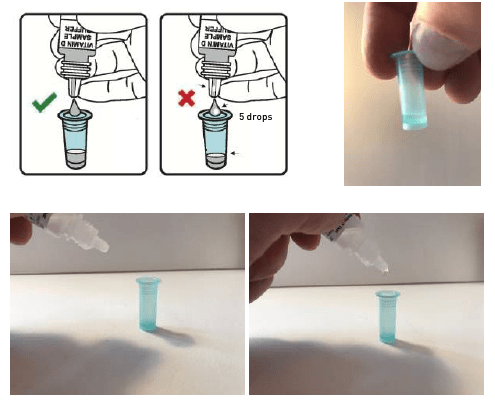
The Specific Task of the Sample Buffer Regarding the Test Process
Vitamin D is fat-soluble. Therefore, it is preferentially stored in the fat tissue. Within the blood it is bound to the Vitamin-D-Binding Protein (VDBP) to facilitate transportation in the blood stream. The particular consistence of the sample buffer forces the effective release of all Vitamin D during mixing of sample and sample buffer. Effective, complete Vitamin-D release from the VDBP is the prerequisite for later Vitamin D detection and quantification on the cassette.
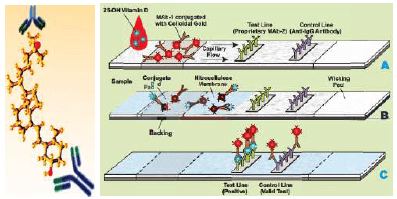
B Continuous lateral flow on the strip. Antibodies mark free Vitamin D.
C The control line forms first, the test line increases dynamically until the end of the test.
Sampling with the UniSampler – 10 μl Whole Blood Exactly Measured
It is important that the finger selected for collecting the sample is warm and well perfused in order to achieve a good sample quality. Eventually, it is recommended to soak the finger in warm water or massage it lightly. Once the fingertip is punctured with an appropriate lancet there is often only a
small drop of blood that should be wiped off with a tissue so that the wound will not close immediately. In case there is only a minor blood flow, massage the finger carefully. Do not “milk out”!
The second drop of blood should be about 2 – 3 mm in size in order fill the capillary of the Blood Collector completely. Monitor this process exactly! If the capillary is not full or contains bubbles you are not applying the right volume and this will impair the reading.
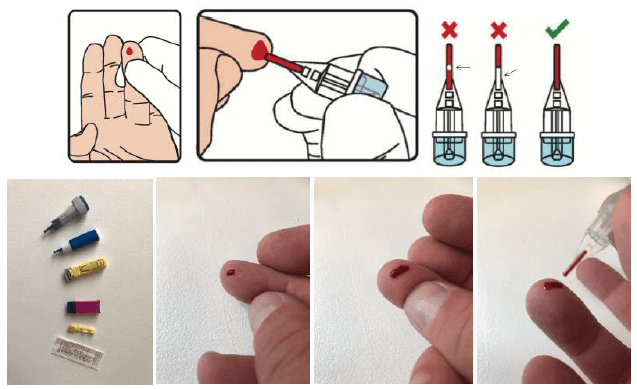
When inserting the Blood Collector with the filled capillary downward into the Collection Tube of the UniSampler until the tip is submersed in the sample buffer pay close attention that the capillary does not accidentally touch the edge or the inside of the Collection Tube.

Sample and Sample Buffer in the UniSampler – Mix Very Thoroughly!
It is of the utmost importance for the quality of the reading that the sample and the buffer are completely mixed. Jerky movements with enough pep of the capillary results in ejecting the sample and subsequent panning with the remainder will ensure a complete mixture. Every user will individually optimize these mixing movements after a few tests. Work thoroughly and monitor exactly for full depletion of the sample from the capillary and complete mixing.

In order to control that the sample and sample buffer are completely mixed, you must observe the UniSampler with transmitted light multiple times. In the beginning the capillary has a distinct intense coloration since the capillary forces still retain most of the sample (A). After complete depletion and mixture, the capillary finally appears a little bit lighter with transmitted light than the sample mixture at the bottom of the Collection Tube of the UniSampler (C).
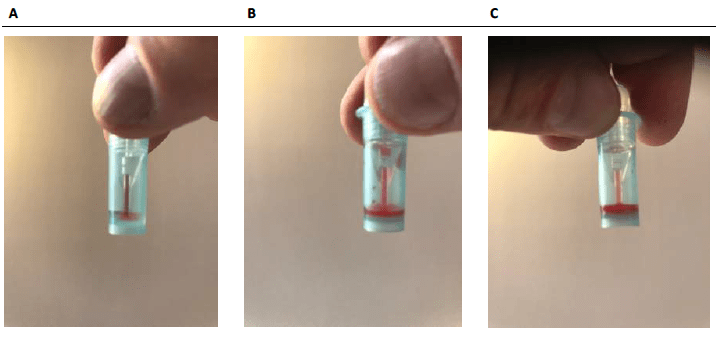
If you do not mix with enough force a large part of the sample remains in the capillary (A). Should the pre-mix from several drops while mixing, make sure to reconnect them again, by slowly panning the UniSampler. It is important that the pre-mix sample is completely mixed and bubble free before applying the sample and accumulates at the bottom of the Collection Tube (C).
Work this step especially thoroughly and monitor multiple times with transmitted light!
Sample Application – Apply Full 3 Drops onto Test Cassette!
The cap of the Blood Collector covers the sample outlet or the drip tube (A) which is used to apply the sample. Again, this important step requires correct measuring.

You must work thoroughly during application onto the test cassette. If a drop touches the surface of the membrane or the previous drop before it is completely formed it will rupture and subsequently not have enough volume. In addition, an embedded air bubble can change the drop volume.
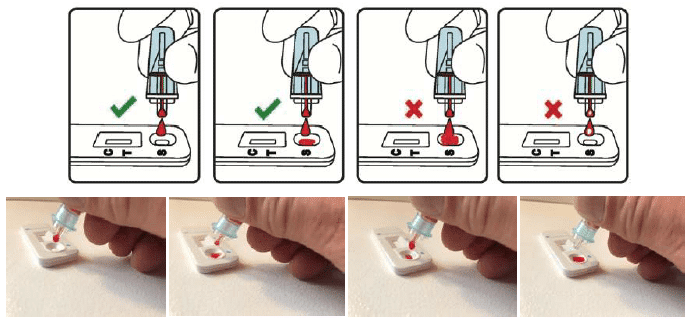
Read after Exact 15 Minutes. – Vitamin-D-Signal Increases Dynamically!
After the sample application, a continuous lateral liquid flow is established in the strip. This creates a controlled process. Pay attention to the clear forming of the control line. The test line appears after some minutes. The Vitamin D signal is dynamically gaining intensity as long as the test performs.

LOT specific calibration data are stored on the RFID card, used to program the VHC-Reader. Pay attention and always check that you use the correct RFID card. Compare the LOT-numbers of the test pouch and the RFID card.
[table id=8 /]
Frequently Asked Questions – FAQ
How do you proceed if the VHC-Reader shows an error although the test has completed successfully and the control line is clearly visible?
Check if you have accidentally inserted the test cassettes in the adapter the wrong way. In this case the VHC-Reader reads the test line as the control line and indicates an error. Also check that the batteries in the VHC-Reader are sufficiently charged. If necessary you can also operate the VHC-Reader with the optional USB-adapter cable (DataReader cable).
What do you do if the control line at the end of the test is not clearly visible or fuzzy in spite of completely applying the sample?
In this case, the test within the cassette has not processed correctly and the Test result must be discarded and the test repeated. Take a photo of a test with a control line indicating an error. Please send us this photo by email together with your contact information and describe briefly yourobservations. We will contact you immediately.
What is the effect if the mixture of the sample buffer is not correct?
Without enough pep when mixing the sample will only exit slowly from the capillary. If the depletion of the sample from the capillary is not monitored exactly it could be that the mixture contains not enough sample. The reading tends to deviate downwards.
What happens if you apply less than 3 whole drops of sample mixture on the test strip?
By applying the pre-mix a continuous lateral flow is generated on the strip of the test cassette which expedites the test process. If the sample inlet becomes dry prematurely due to missing pre-mix volume the test will not run for the full 15 minutes. A weak test line is the result due to a dynamically increasing Vitamin-D-signal over the full 15 minutes. If you are still unsure although working thoroughly apply another drop if necessary. It is important that the sample inlet does not become dry during the entire test process. In doubt, a little too much buffer is not harmful.
How long do the batteries in the VHC-Reader last?
If you use the VHC-Reader only for instant readings and not in the timer modus, the batteries last for up to 100 readings. The more often you use the timer modus, the more battery power is used. If you mostly work in timer modus, you may prefer to operate the VHC-Reader with the special USB adapter cable (DataReader cable). It is available as bundle together with the DataReader software, connection the VHC-REader withj PC.
Where do I find information, videos and training material regarding the VHC Vitamin-D test online?
Please refer to the service on our homepage.
https://vitality-health-check.com/service
We shall update this material from time to time based on your feedback
This is Version 1.1 – Created in February 2018
Copyright 2017 – Jungbrunnen – Fountain of Youth GmbH – www.vitaöity-health-check.
NOTE: THE ORIGINAL/REFERENCE VERSION OF THIS DOCUMENT IS THE ENGLISH VERSION.

